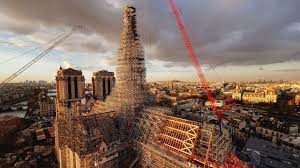Perhaps because February contains Groundhog Day I've been more attracted to previous themes in recent days. This sounds better than being old and repetitive.
My fascination with the restoration of Notre Dame Cathedral, the place of worship that has towered over the heart of Paris for hundreds of years, continues. Following a structural fire resulting in its near collapse five years ago politicians promised that it would open again in time for the Olympic games this summer. This goal was considered unrealistic at the time but Notre Dame may be restored to its former glory, and then some, by the end of the year.
For me, part of my interest comes from my art history undergrad background, with some nostalgia mixed in -- I visited the cathedral for the first time when I was nineteen and roaming around the city on my own. Forty years on I stayed in the rather shabby Hotel Esmeralda, a 17th century building right across the river from the church.
What intrigues me most now is the exceptional attention to detail in the restoration with craftspeople and artisans brought to the project from across France and enlisted for contributions from as far away as Quebec. You may recall my blog about the Montreal blacksmiths who were enlisted to create axes like those used for the original roof timbers 800 years ago. Here is a sample description of the ongoing work from The Economist:
For the roof above the medieval nave and choir, 1,200 oak logs were individually selected from forestry plantations in France and hewn by hand into square timber beams. Craftsmen used hand-forged axes, based on late 12th- and early 13th-century models. On the curved apse roof, finished on January 12th, wooden dowel pegs hold the trusses together without a single industrial metal piece. “The idea was to work with tools that are as close as possible to those used in the Middle Ages in order to give the wood the aspect of the time,” says Valentin Pontarollo, a carpenter from Ateliers Perrault, a firm in western France. One of the joys this brought was that there was often “no machinery noise, just the sound of the axe”, he says.
Not everyone is happy with the restoration, which shouldn't be surprising. The 1,500 new seats and other modern elements are rejected by some, while modernists figure that the opportunity for unique elements to be added has been lost. The interior will look considerably different because the cleaning of stone columns and stained glass has removed the patina of centuries of candle smoke.
I do wonder if the massive cost, exceeding a billion dollars US, is literally a sin. There is so much need in our world. Yet I'm grateful that Notre Dame will carry on, even though I'm quite sure I'll never visit it again.


No comments:
Post a Comment